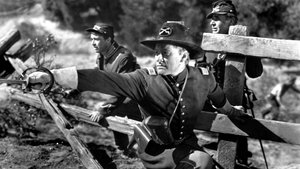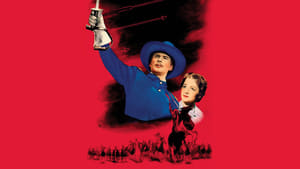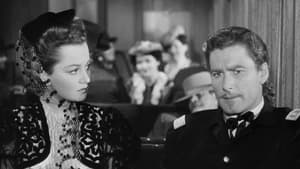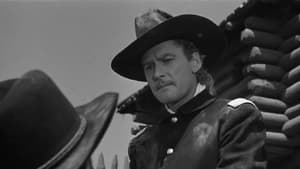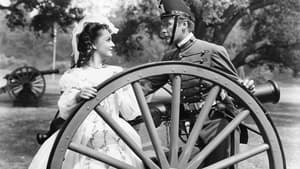Contact: info@alwanfilm.com
Video Sources 0 Views
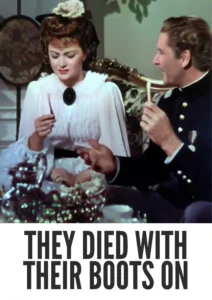
Synopsis
They Died with Their Boots On 1941 Colorized Review: A Western Epic in Early Color

Introduction
“They Died with Their Boots On” (1941) is more than just a typical Western; it is a grand cinematic experience that merges historical narrative with Hollywood’s penchant for embellishment. This Errol Flynn and Olivia de Havilland classic has stood the test of time as one of the most iconic portrayals of General George Armstrong Custer and the Battle of Little Bighorn. What further elevates the film is its early colored version, which, though initially released in black and white, was later colorized, adding a vibrant dimension to its already impressive visual storytelling.
In this article, we will explore the significance of the film’s early colorized version, discuss the impact of colorization on the viewing experience, and delve into how “They Died with Their Boots On” holds a unique place in both the Western genre and film history.
Check The Full Colorized Movies List
Check Our Colorized Movies Trailer Channel
Understanding They Died with Their Boots On 1941 Colorized: Director, Cast, and Genre
“They Died with Their Boots On” was directed by the renowned Raoul Walsh, whose body of work spans several decades and genres, from war films to swashbuckling adventures. Walsh had an eye for crafting action-packed narratives and complex characters, which is evident in his treatment of the larger-than-life figure of General Custer. The film mixes historical facts with Hollywood fiction, presenting Custer not just as a military leader, but also as a tragic hero—valiant, flawed, and ultimately doomed.
The casting of Errol Flynn as Custer was pivotal to the film’s success. Flynn, already a huge star by 1941, was known for his charismatic performances in swashbucklers like “Captain Blood” (1935) and “The Adventures of Robin Hood” (1938). His portrayal of Custer was dynamic, imbued with a mix of bravado, charm, and inevitable tragedy, qualities that Flynn delivered with his signature flair.
Opposite Flynn was Olivia de Havilland, who played Custer’s wife, Elizabeth “Libbie” Bacon. De Havilland, one of Hollywood’s most versatile and talented actresses, was a frequent co-star of Flynn’s, and their on-screen chemistry was palpable. Her role as Libbie gave emotional depth to the film, offering a human side to Custer’s story, away from the battlefield. This pairing of Flynn and de Havilland is central to the film’s enduring appeal.
The genre of “They Died with Their Boots On” falls squarely within the realm of the Western, but its historical elements and grand scale also align it with the epic genre. The film combines sweeping landscapes, intense battle scenes, and the personal drama of its central figures. In a period when Westerns were predominantly low-budget B-movies, Walsh’s film stood out for its ambition, production values, and star power.
Exploring the World of They Died with Their Boots On 1941 Colorized: Plot and Characters
The plot of “They Died with Their Boots On” loosely follows the life of General Custer, focusing on his time at West Point, his Civil War exploits, and his controversial role in the Indian Wars, culminating in the infamous Battle of Little Bighorn, where he meets his tragic end. While the film takes significant liberties with the historical facts—romanticizing Custer’s actions and omitting key details—the story is compelling in its dramatic portrayal of his rise and fall.
Custer is depicted as a fearless, if somewhat reckless, military leader. From the outset, Flynn’s Custer is shown as a man of principle, albeit stubborn and prone to making impulsive decisions. His relationship with his wife, Libbie, humanizes him, presenting a softer, more personal side to the brash military commander.
The supporting cast is equally memorable, with Arthur Kennedy playing Ned Sharp, Custer’s rival and nemesis, and Anthony Quinn as Crazy Horse, the legendary Sioux chief. These characters add layers of complexity to the narrative, as they challenge Custer’s authority and military strategy, ultimately leading to his downfall.
The film’s pacing, dramatic arcs, and character dynamics make it a fascinating watch. The tension builds as the narrative progresses toward its inevitable conclusion—the ill-fated Battle of Little Bighorn. The audience knows Custer is doomed, but the film still manages to maintain suspense and emotional weight until the final moments.
The Art of Film Colorization
Film colorization, the process of adding color to black-and-white movies, was still a developing technique when “They Died with Their Boots On” was later colorized. Initially met with excitement, colorization promised to enhance the visual appeal of older films, breathing new life into classics that had previously been confined to shades of gray. The process involves digitally painting over the black-and-white footage, often requiring meticulous attention to detail to maintain the film’s artistic integrity.
In the early years, colorization was seen as an exciting technological advancement, offering audiences a new way to experience beloved films. However, it also sparked debate among film purists, who argued that the technique altered the original vision of the directors and cinematographers. This controversy plays a significant role in how we view films like “They Died with Their Boots On” today.
Early Colored Films: A Brief History
The history of color in cinema is a fascinating one, marked by numerous technical innovations and artistic breakthroughs. In the early days of film, color was achieved through hand-painting individual frames, a labor-intensive process that produced striking, though inconsistent, results. By the 1930s, the advent of Technicolor revolutionized the industry, allowing filmmakers to shoot entire movies in vibrant color. Films like “The Wizard of Oz” (1939) and “Gone with the Wind” (1939) showcased the potential of Technicolor, setting a new standard for visual storytelling.
However, not all films could afford the expensive color process, and many studios continued to produce black-and-white movies well into the 1940s and 1950s. It wasn’t until the advent of color television and the rise of home video in the 1980s that film colorization became a widespread practice. Studios sought to capitalize on the nostalgia of classic films by releasing colorized versions for a new generation of viewers.
“They Died with Their Boots On” and Its Early Colored Version
“They Died with Their Boots On” was originally released in 1941 in black and white, as color technology was still relatively rare and costly. However, the decision to release a colorized version later on brought a fresh perspective to the film’s epic narrative and sweeping landscapes. The colorization of this particular film added a vibrant layer to its visual storytelling, allowing modern audiences to appreciate the grandeur of the Western setting in full color.
The decision to colorize the film was not without its challenges. Colorizing historical films like “They Died with Their Boots On” often required guesswork, as there was little documentation on the specific hues used on set. Nevertheless, the colorized version offers a new way to engage with the film, adding a different emotional tone to certain scenes and bringing new life to the period costumes and dramatic landscapes.
The Debate Over Film Colorization
Film colorization has been a source of ongoing controversy since its inception. While some argue that it enhances older films, making them more accessible to contemporary audiences, others believe it detracts from the original artistic intent. Directors like Martin Scorsese and Steven Spielberg have been vocal critics of colorization, viewing it as a violation of the filmmaker’s original vision.
“They Died with Their Boots On” is an interesting case in this debate, as its black-and-white version is deeply atmospheric, using shadows and contrast to create a certain mood. The colorized version, by contrast, is more vivid and dynamic, but it alters the tone of certain scenes. For instance, the Battle of Little Bighorn, filmed in stark, high-contrast black and white, becomes a more visually immersive experience in color, but some argue that the raw intensity of the original is diminished.
Examining “They Died with Their Boots On” as an Early Colored Film
As one of the earlier films to receive the colorization treatment, “They Died with Their Boots On” provides a fascinating example of how this technology can both enhance and alter a film’s aesthetic. The vast plains and rugged terrain of the American West come to life in the colorized version, making the setting feel more immediate and real. Costumes, which are crucial to the visual storytelling of the period, gain new depth, with Custer’s iconic blue cavalry uniform standing out against the natural landscape.
However, there are moments where the colorization feels less natural, particularly in scenes of battle or moments of high emotional intensity. The original black-and-white cinematography used light and shadow to heighten drama, and some of that impact is lost in the transition to color. Still, for audiences unfamiliar with the original, the colorized version offers a visually engaging experience that highlights the film’s grandeur.
Influence and Legacy: They Died with Their Boots On 1941 Colorized’s Impact on Cinema
“They Died with Their Boots On” has had a lasting impact on the Western genre and on Hollywood’s approach to historical epics. Its portrayal of Custer as a tragic hero laid the groundwork for future Westerns that would explore the darker, more complex aspects of American history. The film’s blend of romance, action, and historical drama influenced later films like “A Fistful of Dollars” (1964) and Sergio Leone’s spaghetti Westerns, which took a more cynical view of the West but shared Walsh’s ambition for larger-than-life storytelling.
Moreover, Errol Flynn’s portrayal of Custer became a cultural touchstone, inspiring numerous reinterpretations of the character in both film and television. His combination of charm, bravado, and vulnerability made Custer a sympathetic figure, despite the controversies surrounding the real-life figure’s military actions.
Director’s Cinematic Legacy: Beyond They Died with Their Boots On 1941 Colorized
Raoul Walsh’s directorial career spanned over five decades, and his influence on cinema cannot be overstated. Known for his ability to work across genres, Walsh brought a dynamic, action-oriented style to films like “White Heat” (1949) and “The Roaring Twenties” (1939). His work on “They Died with Their Boots On” exemplifies his skill at combining spectacle with character-driven storytelling. His influence can be seen in later directors like John Ford, whose Westerns often carried the same mix of myth and history.
Walsh’s cinematic legacy continues to inspire filmmakers around the world, and his work on “They Died with Their Boots On” remains a defining moment in his career.
Themes Explored in They Died with Their Boots On 1941 Colorized
“They Died with Their Boots On” touches on several themes that resonate with audiences even today. The film explores the concept of honor, both in the military and in personal relationships, as Custer’s decisions are often driven by his sense of duty and loyalty. The film also delves into the darker aspects of American history, particularly the treatment of Native Americans, though it does so through the lens of 1940s Hollywood, where historical accuracy often took a back seat to entertainment.
The themes of heroism, sacrifice, and the inevitability of death loom large over the narrative, as Custer’s fate is sealed from the start. The film presents his story as one of tragic inevitability, with the character’s flaws and virtues intertwining in his downfall.
Reception and Controversy Surrounding They Died with Their Boots On 1941 Colorized
Upon its initial release, “They Died with Their Boots On” received mixed reviews. While many praised Flynn’s performance and the film’s epic scale, some critics took issue with its historical inaccuracies. However, over time, the film has gained a cult following, with many appreciating it as a product of its time—a romanticized, larger-than-life portrayal of the Old West.
The colorized version, released decades later, reignited interest in the film but also sparked controversy among film purists. While some appreciated the new visual experience, others lamented the loss of the original black-and-white aesthetic.
Where to Watch They Died with Their Boots On 1941 Colorized Online
Today, “They Died with Their Boots On” is available on several streaming platforms, making it easily accessible to both new viewers and longtime fans. Platforms like Amazon Prime, HBO Max, and Apple TV offer the film in its original black-and-white version, while the colorized version can be found on DVD and Blu-ray releases.
FAQs About They Died with Their Boots On 1941 Colorized
Q: Is “They Died with Their Boots On” based on a true story?
A: While the film is based on historical figures and events, it takes significant liberties with the facts, romanticizing Custer’s life and actions.
Q: Why was the film colorized?
A: The film was colorized to attract new audiences and offer a fresh perspective on the classic story, though the original black-and-white version is still widely available.
Q: Where was “They Died with Their Boots On” filmed?
A: The film was primarily shot in California, with several outdoor scenes filmed on location to capture the expansive Western landscapes.
Conclusion
“They Died with Their Boots On” (1941) remains an enduring classic in the Western genre, thanks to its powerful performances, epic narrative, and ambitious scope. The film’s early colorized version offers a unique viewing experience, though it continues to be the subject of debate among film enthusiasts. Whether in color or black and white, the film’s legacy as a touchstone of American cinema is undeniable, and its exploration of heroism, honor, and tragedy continues to captivate audiences to this day.
For those who appreciate classic films, “They Died with Their Boots On” is a must-watch—preferably in its original format—to fully appreciate Raoul Walsh’s directorial vision and Errol Flynn’s iconic performance as General George Armstrong Custer.

